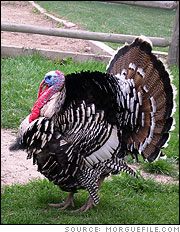Turkey Facts


Do you know what male turkeys are called? Do turkeys roost in trees at night? Find out the answers to turkey trivia with our fast & fascinating facts about the wild turkey population and domesticated turkeys in the United States!
 Related Links |
How Did the Turkey Get Its Name?
While the scientific name for the turkey is Meleagris gallopavo, it’s not always been classified as such.
There are a number of explanations for the origin of the name of Thanksgiving's favorite dinner guest. Some believe Christopher Columbus, sailing from Europe, thought that the land he discovered was connected to India, and believed the bird he discovered (the turkey) was a type of peacock. Therefore, he called it “tuka,” which is a “peacock” in Tamil, a primary language in India.
Though the turkey is actually a type of pheasant, one can't blame the explorer for trying. And the land mass wasn’t India, either— it was North America!
The Native American name for turkey is “firkee”; some say this is how turkeys got their name. Simple facts, however, sometimes produce the best answers—when a turkey is scared, it makes a "turk, turk, turk" noise.
Read on for some turkey trivia that will tickle your tastebuds and your brain, including turkey facts for kids, turkey history, and the birds near brush with Ben Franklin.
Fun Turkey Facts
- Did you know? Male turkeys are the only ones who emit that classic “gobble” sound. So, if you hear gobblers in the bushes, you can be sure that they’re not female turkeys!
- The red, skin dewlap that hangs underneath a turkey’s chin is called a “wattle”. Similarly, the fleshy hood that grows around a turkey’s head is called a “snood”.
- According to the U.S. Department of Agriculture, more than 45 million turkeys are cooked and eaten in the U.S. at Thanksgiving— that's one-sixth of all turkeys sold in the U.S. each year. American per capita consumption of turkeys has soared from 8.3 pounds in 1975 to 18.5 pounds in 1997 and has remained stable at about 16 pounds of turkey since 2011.
- Raising turkeys has been expanding since the early 1900s. In 2014, 235 million turkeys were raised. Compare this with the record low of 17.1 million birds in 1930, and the record high of 302.7 million in 1996.
- Turkeys are fed a diet of mainly corn and soybean meal along with a supplement of vitamins and minerals. They grow to full maturity in about 4 to 5 months, depending on the desired market weight.
- Male turkeys are called tom turkeys— but sadly, there’s no jerry turkeys.
- Did you know? Turkeys are old: over 45 million years lie between them and modern chickens.
- Age is a determining factor in taste. Old, large males are preferable to young toms (males) as tom meat is stringy. The opposite is true for females: old hens are tougher birds.
- A turkey under sixteen weeks of age is called a fryer, while a young roaster is five to seven months old.
- Turkeys enjoy a varied diet, including berries and insects when young, and when they get older, eat seeds, acorns, and even small reptiles like geckos.
- Turkeys are the only breed of poultry native to the Western Hemisphere.
- There are also six subspecies of the turkey that exist across North America, including the Eastern wild turkey (Meleagris gallopavo silvestris) eaten by many of the European pilgrims, and the forest turkey.
- Turkeys have great hearing, but no external ears. They can also see in color, and have excellent visual acuity and a wide field of vision (about 270 degrees), which makes sneaking up on them difficult. However, turkeys have a poor sense of smell (what's cooking?), but an excellent sense of taste.
- Domesticated turkeys cannot fly. Wild turkeys, however, can become airborne for short distances at speeds up to 55 miles per hour. They can also reach speeds of 25 miles per hour on the ground.
- Did you know? Turkeys are noisy creatures! Apart from gobbling, you might hear a turkey purr, cluck, or yelp.
- Turkeys sometimes roost in branches to spend the night in trees.
- The turkey might be a wild animal and a game bird, but it was almost the National Bird of the United States, as well, thanks to Benjamin Franklin! The founding father suggested that the wild turkey be made the National Bird, instead of the bald eagle, but Ben Franklin was ultimately unsuccessful.
- Turkeys can have heart attacks: turkeys in fields near the Air Force test areas over which the sound barrier was broken were known to drop dead from the shock of passing jets
- The ballroom dance known as the Turkey Trot was named for the short, jerky steps a turkey makes.
- A group of turkeys is called a “rafter”.
- Found in Southern Mexico, the Aztec people also had domesticated turkeys called the Meleagris gallopavo gallopavo, which also made its way back to the North American states, thanks to trade.
- Did you know? Baby turkeys are called poults.
For more turkey trivia see Fowl FAQs, and wet your whistle with more festive Thanksgiving Features!
About the author







